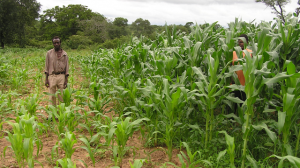There’s something delicious about received wisdom being overturned. For example, you’ll hear it said, categorically, that livestock turn fragile landscapes into desert; they eat the plants binding the soil, and their hooves cut up the surface and promote erosion. But it ain’t necessarily so.
Operation Hope, a Zimbabwean NGO and winners of $100,000 Grand Prize in the Buckminster Fuller Challenge, has
[T]ransformed 6,500 acres of of parched and degraded grasslands in Zimbabwe into lush pastures replete with ponds and flowing streams – even during periods of drought.
The quote is from a write-up in Seed magazine, which gives lots of details of the story. In essence, the key to livestock and grasslands is time, not numbers. If animals are on the land too long, their hooves do indeed powder the soil and they do overgraze. But if they are free to move on, or are moved by herders, moderate trampling allows rain to percolate into the soil, rather than run off and cause erosion. It also improves contact between seeds and soil, promoting germination. And dung and urine return plant matter to the soil to increase fertility and sequester more carbon, without becoming pollutants.
Operation Hope grazes animals in one spot for a maximum of three days, and they do not return for at least nine months, mimicking the natural movements of large herbivores on the savannah. At night they are protected from predators in portable kraals, which are also mobile to prevent a build-up of dung and urine. The effects are impressive. (“Animal-treated” field on the right, conventionally managed field on the left. Image courtesy Buckminster Fuller Institute”)

What’s interesting, and this is explored in much more detail in the Seed article, is that this kind of ecosystem thinking, which requires human knowledge and ingenuity to tackle complex problems, could have applications well beyond range management. Allan Savory, the scientist behind Operation Hope and the Africa Centre for Holistic Management, is hard on the Green Revolution.
“We posit the necessity of a new ‘Brown Revolution’, based on the regeneration of covered, organically rich, biologically thriving soil, and brought to fruition via millions of human beings returning to the land and the production of food.”
Of course, that’s hard work. But it is also surely much more interesting and fulfilling.